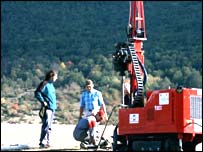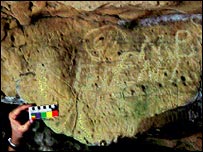Space impact 'saved Christianity'
By Dr David Whitehouse
Did a meteor over central Italy in AD 312 change the course of Roman and Christian history?
A team of geologists believes it has found the incoming space rock's impact crater, and dating suggests its formation coincided with the celestial vision said to have converted a future Roman emperor to Christianity.
It was just before a decisive battle for control of Rome and the empire that Constantine saw a blazing light cross the sky and attributed his subsequent victory to divine help from a Christian God.
Constantine went on to consolidate his grip on power and ordered that persecution of Christians cease and their religion receive official status.
Civil war
In the fourth century AD, the fragmented Roman Empire was being further torn apart by civil war. Constantine and Maxentius were bitterly fighting to be the sole emperor.
Constantine was the son of the western emperor Constantius Chlorus. When he died in 306, his father's troops proclaimed Constantine emperor.
...a most marvellous sign appeared to him from heaven...
Eusebius
But in Rome, the favourite was Maxentius, son of Constantius' predecessor, Maximian.
With both men claiming the title, a conference was called in AD 308 that resulted in Maxentius being named as senior emperor along with Galerius, his father-in-law. Constantine was to be a Caesar, or junior emperor.
The situation was not a stable one, however, and by 312 the two men were at war.
Constantine overran Italy and faced Maxentius at the Milvian Bridge over the Tiber a few kilometres from Rome. Both knew it would be a decisive battle with Constantine's forces outnumbered.
'Conquer by this'
It was then that something strange happened. Eusebius - one of the Christian Church's early historians - relates the event in his Conversion of Constantine.
"...while he was thus praying with fervent entreaty, a most marvellous sign appeared to him from heaven, the account of which it might have been hard to believe had it been related by any other person.
|
"...about noon, when the day was already beginning to decline, he saw with his own eyes the trophy of a cross of light in the heavens, above the Sun, and bearing the inscription 'conquer by this'.

"At this sight he himself was struck with amazement, and his whole army also, which followed him on this expedition, and witnessed the miracle."
Spurred on by divine intervention, Constantine's army won the day and he gave homage to the God of the Christians whom he believed had helped him.
This was a time when Christianity was struggling. Support from the most powerful man in the empire allowed the emerging religious movement to flourish.
Like a nuclear blast
But what was the celestial event that converted Constantine and altered the course of history?
Jens Ormo, a Swedish geologist, and colleagues working in Italy believe Constantine witnessed a meteoroid impact.
Drill rig: Sampling the crater
The research team believes it has identified what remains of the impactor's crater.
It is the small, circular Cratere del Sirente in central Italy. It is clearly an impact crater, Ormo says, because its shape fits and it is also surrounded by numerous smaller, secondary craters, gouged out by ejected debris, as expected from impact models.
 Radiocarbon dating puts the crater's formation at about the right time to have been witnessed by Constantine and there are magnetic anomalies detected around the secondary craters - possibly due to magnetic fragments from the meteorite. Radiocarbon dating puts the crater's formation at about the right time to have been witnessed by Constantine and there are magnetic anomalies detected around the secondary craters - possibly due to magnetic fragments from the meteorite.
According to Ormo, it would have struck the Earth with the force of a small nuclear bomb, perhaps a kiloton in yield. It would have looked like a nuclear blast, with a mushroom cloud and shockwaves.
It would have been quite an impressive sight and, if it really was what Constantine saw, could have turned the tide of the conflict.
But what would have happened if this chance event - perhaps as rare as once every few thousand years - had not occurred in Italy at that time?
Maxentius might have won the battle. Roman history would have been different and the struggling Christians might not have received state patronage.
The history of Christianity and the establishment of the popes in Rome might have been very different.
|
|
|
|
 |
'Sorcerers' buried alive, burnt, raped and stoned, says minister
June 19 2003
Women accused of sorcery in Papua New Guinea are being burned at the stake, stoned, raped, axed, buried alive, electrocuted, forced to drink petrol and dragged behind vehicles, according to a government minister.
Minister for Welfare Lady Carol Kidu said this yesterday in an appeal to foreign aid donors to fund research into sorcery in PNG, where many citizens cling to ancient beliefs in black magic and "payback" attacks.
After receiving evidence from doctors working with victims, Lady Kidu said she was horrified by the brutal methods of torture and murder employed against the accused - most of whom were older women.
She said the sorcery interrogations were usually carried out by young men.
The methods of torture included beating (often with barbed wire), breaking bones, burning with red hot metal, raping, hanging over fire, cutting body parts slowly, amputating and pulling behind vehicles, she said in a statement.
"Mostly, however, if the victim is not dead she is then killed by one of the following methods: Execution, being thrown over a cliff, into a river or cave, burned alive in a
housefire, buried alive, beheaded, hanged, choked to death, starved, axed or electrocuted, suffocated with smoke, forced to drink petrol or hot liquid, stoned or shot".
|
 Lady Kidu said bystanders were afraid to intervene as they themselves might be accused of sorcery. Lady Kidu said bystanders were afraid to intervene as they themselves might be accused of sorcery.
Police were also reluctant to intervene, dismissing such crimes as "samting bilong
ples" (things that should stay in the village).
Doctors had told her sorcery accusations were increasing, prompting fear within village communities.
"Sorcery and witchcraft exist in many societies and education and legislation have been used to reduce its negative effect on society in other places," she said.
Doctors seeking funds to research the medical and socio-legal implications of sorcery had told her that women were six times more likely to be accused than men.
"They were often older, unprotected women who could be viewed as an economic burden on the tribe," Lady Kidu said.
Lady Kidu was briefed by two doctors on a recent trip to the highlands town of
Goroka.
However, sorcery attacks in PNG are not restricted to the more primitive regions of the highlands.
This month a woman accused of sorcery was hacked to death and dumped in a river just outside the capital Port Moresby.
The victim's husband and son were also attacked with axes by rival tribesmen.
|
 |
|
|
Britain's 'earliest' prehistoric cave art
By Dr David Whitehouse
Archaeologists have discovered the earliest known example of prehistoric cave art in Britain.
 It consists of 12,000-year-old engravings of birds and an ibex carved into the stone walls at Creswell Crags, Derbyshire. It consists of 12,000-year-old engravings of birds and an ibex carved into the stone walls at Creswell Crags, Derbyshire.
Above an enhanced view: This image traces the
outline of the ibex
The identification was made by Paul Bahn and Paul Pettitt, with Spanish colleague Sergio Ripoll.
They report their findings in the journal Antiquity.
There are fine examples of cave art in France and Spain but none has been found in the UK - until now.
The British art is less impressive than the paintings found in continental caves. It is also substantially younger.
|
Continental style
It is thought modern humans appeared in Europe around 45,000 years ago. Over a time span of about 15,000 years, they replaced the continent's then occupants, the Neanderthals.
The newcomers produced some remarkable works. The best of these are the stampeding horses and charging bulls painted at Lascaux and Chauvet in France, and at Altamira in Spain.
It is surprising that Palaeolithic cave art has not been identified in the UK before now because the British Isles was linked to the continent during this time and known to have been inhabited.
However, experts believe that most cave paintings would have been destroyed in Britain's damp climate.
 The researchers examined the Creswell Crags because of previous Stone Age discoveries at that location. In the 19th Century a 12,000-year-old bone needle was found there. The researchers examined the Creswell Crags because of previous Stone Age discoveries at that location. In the 19th Century a 12,000-year-old bone needle was found there.
Bahn, Pettitt and Ripoll say the engravings are of a style similar to the cave art of France and Spain.
Of the two birds carved on the wall of the cave, one might be a crane or swan, the other a bird of prey. The other engraving could be an ibex, an animal not thought to have existed in Britain.
|

|

